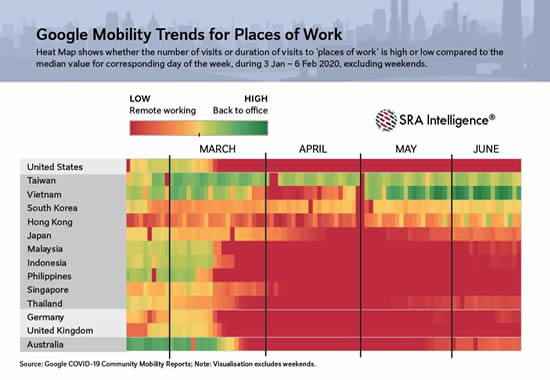 |
Asian Skies - charting the recoveryBy Michael Walsh, CEO, Pacific Basin Economic Council (PBEC). |
Let’s start with China - the largest aviation market for commercial and business aviation activity in East Asia. Here, domestic demand has been a dominant factor as we move into the recovery phase - with the loosening of social distancing and lock-down measures within their own borders.
China’s largest charter brokerages, Global Wings and Air Charter Service’s (ACS) Beijing branch offices have been experiencing an 85% recovery in charter activity, compared with YoY 2019 figures for May and June. International trip requests also increased with the announcement of new travel bubbles. Many of these still can’t be fulfilled however, as border and quarantine restrictions remain in place.
Popular destinations for charter are between the major Tier 1 cities domestically in China such as Beijing, Shanghai, Guangzhou and Shenzhen and also to Hainan Island – Sanya and Haikou for leisure and business. There is also demand for Chengdu and Qingdao. Passengers must adhere to a strict colour coded QR system which permits travel (or not) under the national track and trace system.
Charter demand is coming from traditional, larger brokerages and local brokers who control certain client accounts. New enquiries are originating primarily from Chinese individuals and companies outside of China, who wish to fly to China’s mainland from Malaysia/Indonesia/Singapore and Vietnam. Borders remain highly restrictive unless your clients have a genuine Government invitation, residency permit or nationality, as long as sufficient documentation and reason for travel is provided.
Chinese and other local Asian-based operators expect further demand for a short period, but many are predicting a ‘W’ shaped recovery. The FBOs in Hong Kong and Macau have witnessed a major decline in movements since March.
VistaJet and Qatar Executive have floating aircraft in and out of Hong Kong during the pandemic. QAE is preparing to launch a new charter product very soon, Mark Hardman Acting SVP acknowledged last week, specifically targeting Middle East and Chinese clients. QAE sees strong demand from Greater China, but both are foreign operators, which restricts them to six consecutive sectors including entry and exit legs within domestic China only, but its sufficient for the current demand.
Overstay parking has become a major issue at Hong Kong International Airport, with over 93 aircraft currently parked, taking up 79 official spots including off-stand ones. Typhoon season typically starts in July and authorities are applying pressure to management firms for parked aircraft to be moved.
In the ASEAN region - Malaysia has seen an uptick in domestic flights, both scheduled and private charter even though cabotage is restricting foreign registered operators from flying domestic legs, (with some exemptions.) Indonesia, one of the worst affected Covid crisis countries) also relies heavily on domestic services and traffic is beginning to pick up.
Vietnam’s domestic economy is now back to pre-Covid levels but it is set to be adversely affected by international inbound business & tourism sectors. Vietnam had the fastest growing business aviation fleet in the ASEAN region pre-Covid, with economists forecasting the country would be a top performer, aided by zero deaths and being virus free for over six weeks now.
Australia, Japan and New Zealand have a healthy local domestic charter with demand returning since the end of May.
In Malaysia, charter has been strengthened by political and business needs, typically from Subang to Kota Kinabalu, Langkawi and Kuching. Some politicians are making plans and visiting constituents in anticipation of a possible snap election as a result of the ongoing uncertainties.
Singapore, much like Hong Kong, is very dependent on international traffic, which has not returned thus far. Traffic was steady in March, but took a big dip from April to June. Singapore have only just come out of their circuit breaker and now the Prime Minister has called an election, throwing up operational obstacles that will impact non-scheduled flights, except maintenance and training flights for crews.
Hong Kong’s attempt at creating a travel bubble with neighbouring Macau and Guangdong, originally planned for May 16, has stalled, city leader Carrie Lam Cheng Yuet-ngor confirmed last week. The set back centred on quarantine restrictions that would hamper the movement of people.
The 14-day quarantine, just like in Europe, is blighting most international trip requests. Some countries like Taiwan have a reduced its quarantine to a 5-7 day period, but tracing needs to be recorded during a traveller’s entire journey. Sharon Dai from CAPA Centre for Aviation challenges that authorities have been slow in coming up with agreements. Director General Subhas Menon from the Association of Asia-Pacific Airlines is also calling for travel restrictions to be relaxed and quarantine measures to be lifted, but at the tme of writing there is more talk than action which is dashing hopes of the travel bubbles that would enable a controlled flow of people between places.
Which countries are returing to work?
My colleague, Board Director at PBEC Ben Simpfendorfer of Silk Road Associates (SRA Intelligence) recently created a simple visualization using Google’s Mobility analytics to illustrate just how fast (or slow) countries are returning to work around the world.
(The data is based on Google’s definition for ‘places of work’ and there will be differences between emerging and advanced economies).
In Asia it shows that Taiwan and Vietnam are operating at pre-Covid-19 speed with South Korea and Hong Kong not far behind. Southeast Asia faces a more difficult choice in deciding how to open selectively.
China, Korea, Taiwan and Vietnam are largely back to work, which is good as they collectively account for 55% and 19% of global consumer goods and machinery exports. The problem is a lack of global demand now, not supply.
Indonesia and The Philippines have not returned yet and face the challenge of reopening their economies selectively even as they seek to contain their virus hotspots. Thailand just announced they are opening their borders and do not require 14 days quarantine, which is the first welcomed news in July.

Asian Governments need to invest in aviation
Inevitably, as I see it, Asian Governments will have to step in and subsidise some airports, like they have with their national carriers. Supporting the further development of business and general aviation sectors is a key economic driver, because it has a long way to grow compared with the more mature markets of the USA and Europe and the oversupply that was already a factor in poor yields pre-covid, on the commercial airliner side.
I am starting to receive initial enquiries from ASEAN based airports on how they can attract new segments of aviation, including supply chain localisation, digital transformation and creating investment hubs that foster aerospace ecosystems around a destination airport. It bodes well if you have the stomach and patience for the next decade of disruption and innovation.

 |
Michael Walsh has 23 years of global aerospace experience across the aviation industry. He lobbies, advocates, educates corporations and Government agencies on the importance of environmental, social and good governance responsibilities. A recent initiative was to commence the awareness and adoption of Alternative Aviation Fuels in Asia Pacific, partnering with industry, and transforming airport infrastructure to be fit for purpose post 2030. |
| He started his aviation career at Aer Lingus, before moving into business aviation, working with Air Charter Service, Asia Jet and HongKong Jet. His latest consultancy firm is Aer Mobi, a provider of market intelligence and economic insights from the Asian region. In May 2019 Mike was appointed CEO of PBEC – Pacific Basin Economic Council in May 2019, a membership-based INGO, established since 1967. | |
www.aermobi.aero | www.pbec.org
BlueSky Business Aviation News | 18th June 2020 | Issue #562
Share this article



